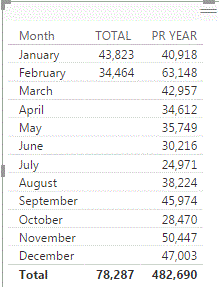- Power BI forums
- Updates
- News & Announcements
- Get Help with Power BI
- Desktop
- Service
- Report Server
- Power Query
- Mobile Apps
- Developer
- DAX Commands and Tips
- Custom Visuals Development Discussion
- Health and Life Sciences
- Power BI Spanish forums
- Translated Spanish Desktop
- Power Platform Integration - Better Together!
- Power Platform Integrations (Read-only)
- Power Platform and Dynamics 365 Integrations (Read-only)
- Training and Consulting
- Instructor Led Training
- Dashboard in a Day for Women, by Women
- Galleries
- Community Connections & How-To Videos
- COVID-19 Data Stories Gallery
- Themes Gallery
- Data Stories Gallery
- R Script Showcase
- Webinars and Video Gallery
- Quick Measures Gallery
- 2021 MSBizAppsSummit Gallery
- 2020 MSBizAppsSummit Gallery
- 2019 MSBizAppsSummit Gallery
- Events
- Ideas
- Custom Visuals Ideas
- Issues
- Issues
- Events
- Upcoming Events
- Community Blog
- Power BI Community Blog
- Custom Visuals Community Blog
- Community Support
- Community Accounts & Registration
- Using the Community
- Community Feedback
Register now to learn Fabric in free live sessions led by the best Microsoft experts. From Apr 16 to May 9, in English and Spanish.
- Power BI forums
- Forums
- Get Help with Power BI
- Desktop
- fiscal year compared to prior year
- Subscribe to RSS Feed
- Mark Topic as New
- Mark Topic as Read
- Float this Topic for Current User
- Bookmark
- Subscribe
- Printer Friendly Page
- Mark as New
- Bookmark
- Subscribe
- Mute
- Subscribe to RSS Feed
- Permalink
- Report Inappropriate Content
fiscal year compared to prior year
I have total costs for the current year compared to the prior year by month. (PR YEAR = CALCULATE(SUM(DATA[TOTAL]),PARALLELPERIOD(DATES[Date].[Date],-12,MONTH))
I would like to see this for the fiscal year. In my DATES table, I have: FiscalYearNumber = If( Month([Date]) >= 7 , Year([Date])+1,Year([Date]) ) and FiscalMonth = (If( Month([Date]) >= 7 , Month([Date]) - 6,Month([Date]) + 6 ))
How do I adjust the PR YEAR to calculate based on my new fiscal year and month?
Solved! Go to Solution.
- Mark as New
- Bookmark
- Subscribe
- Mute
- Subscribe to RSS Feed
- Permalink
- Report Inappropriate Content
Hi @Ria,
>>If my calendar date is Aug 28/YY then the fiscal date is 02/28/YY, but calendar date Aug 29/YY becomes 03/1/YY.
By default, the date function will auto convert the date calculation.
I also not found a better solution to solve this issue. In my opinion, I'd like to suggest you to ignore the "day" of fiscal date, only keep the year and month.
Notice: Fiscal date not the real date, you not need to care about the detail day of date. You only need to ensure the original data are in the same month.
Regards,
Xiaoxin Sheng
If this post helps, please consider accept as solution to help other members find it more quickly.
- Mark as New
- Bookmark
- Subscribe
- Mute
- Subscribe to RSS Feed
- Permalink
- Report Inappropriate Content
Hi @Ria,
You can add a calculage column to calculate the fiscal date, then modify your formula based on it.
Sample:
Fiscal Date = DATE(If( Month([Date]) >= 7 , Year([Date])+1,Year([Date])),If( Month([Date]) >= 7 , Month([Date]) - 6,Month([Date]) + 6 ),DAY([Date]))
Regards,
Xiaoxin Sheng
If this post helps, please consider accept as solution to help other members find it more quickly.
- Mark as New
- Bookmark
- Subscribe
- Mute
- Subscribe to RSS Feed
- Permalink
- Report Inappropriate Content
This mostly works except that it does not account for the fact that all months do not have the same number of days. If my calendar date is Aug 28/YY then the fiscal date is 02/28/YY, but calendar date Aug 29/YY becomes 03/1/YY. Is there a way to account for this?
- Mark as New
- Bookmark
- Subscribe
- Mute
- Subscribe to RSS Feed
- Permalink
- Report Inappropriate Content
Hi @Ria,
>>If my calendar date is Aug 28/YY then the fiscal date is 02/28/YY, but calendar date Aug 29/YY becomes 03/1/YY.
By default, the date function will auto convert the date calculation.
I also not found a better solution to solve this issue. In my opinion, I'd like to suggest you to ignore the "day" of fiscal date, only keep the year and month.
Notice: Fiscal date not the real date, you not need to care about the detail day of date. You only need to ensure the original data are in the same month.
Regards,
Xiaoxin Sheng
If this post helps, please consider accept as solution to help other members find it more quickly.
- Mark as New
- Bookmark
- Subscribe
- Mute
- Subscribe to RSS Feed
- Permalink
- Report Inappropriate Content
Good idea. I made the day the first day of the month so that the month is always correct.
Fiscal Date = DATE(if(month([Date].[Date]) >=7, Year([Date].[Date])+1,year([Date].[Date])),if(month([Date].[Date])>=7, month([Date].[Date]) - 6, Month([Date].[Date]) +6),1)
Helpful resources

Microsoft Fabric Learn Together
Covering the world! 9:00-10:30 AM Sydney, 4:00-5:30 PM CET (Paris/Berlin), 7:00-8:30 PM Mexico City

Power BI Monthly Update - April 2024
Check out the April 2024 Power BI update to learn about new features.

| User | Count |
|---|---|
| 109 | |
| 96 | |
| 77 | |
| 66 | |
| 54 |
| User | Count |
|---|---|
| 144 | |
| 104 | |
| 102 | |
| 88 | |
| 63 |

